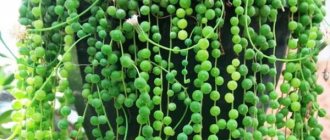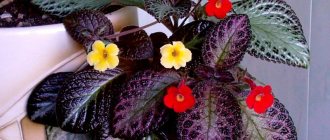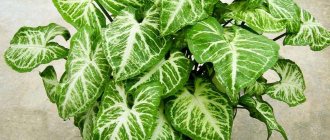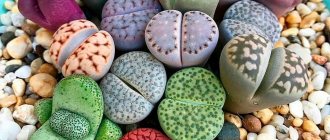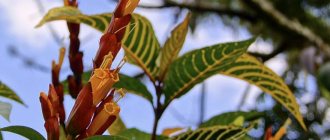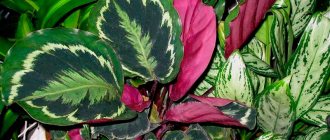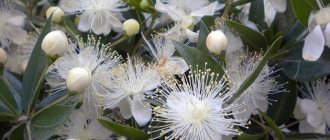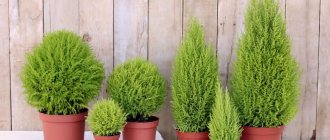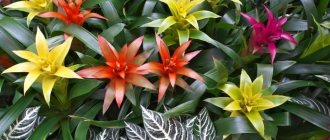Euphorbia is one of the most extraordinary plants. Over 1,500 varieties grow in nature, more than a hundred of which are decorative and suitable for indoor cultivation. The varieties of this plant have a very diverse appearance, but caring for milkweed is relatively easy and that is why they are frequent guests in our homes.
Euphorbia indoor description
Euphorbia (Euphorbia) is an evergreen perennial belonging to the genus Euphorbia. South-East Africa is considered the birthplace of culture. In addition, the plant grows in Asia and America. The family includes herbs, trees, shrubs and succulents.
homemade spurge photo
Euphorbia indoors is a decorative flower. Photos of the plant on flower forums prove that the types of crops are completely different from each other. One of them can grow into a real tree, the other can be prickly like a cactus, or even have an intricate shape that is not found in nature. A common feature of all varieties of euphorbia is the presence of milky milky juice. Inflorescences in external characteristics vary depending on the variety. Buds can be unpresentable, inconspicuous, colorful and interesting.
Possible problems in growing milkweed
Often, when growing milkweed, you can note the occurrence of certain problems. The most common of them include:
- fall of green mass. Most often, an unpleasant situation occurs against the background of a lack of sunlight. You should move containers with flowers to a bright area as soon as possible. You can give preference to places near the window;
- yellowing and drying of the foliage indicate an invasion of parasites or a lack of moisture. It is important to process the plant in a timely manner or moisten the soil;
- wilting can be caused not only by the influence of pests, but also by an ordinary draft. Flower pots should be moved to a more suitable area. If necessary, treatment for parasites is carried out.
Euphorbia belongs to the category of fairly unpretentious plants that can be grown not only indoors, but also in the garden in the summer. The abundance of flower varieties will help you choose the perfect plant for any interior design.
Types of milkweed
According to various sources, the genus of milkweed has about 1000-2000 species. Only a small proportion of varieties can grow exclusively in the wild. Most species are successfully cultivated as houseplants.
Informative! Euphorbia received the name “euphorbia” from the Roman physician Dioscarides in honor of his colleague Euphorbus, who learned to prepare healing potions from the culture.
The most common types are:
- Euphorbia bordered is an annual variety, reaching a height of 0.7-0.8 m. The stems are straight, the leaves are oval, about 4 cm long. When flowering, the edges of the foliage are covered with a white border.
- Euphorbia White-veined is a herbaceous perennial, small palm tree, native to Madagascar. In the natural environment it can reach 1.5 m in height. Young shoots are solitary, more mature shoots are branched. The foliage is ovoid. On the front side the leaves are a rich green shade with clear white lines, on the back they are pale green.
- Euphorbia triangular (triangular) is a branching succulent that reaches a height of 2 m. South-West Africa is considered its homeland. The stem grows vertically. The leaf has three flat edges. At the top there are many brown-red spines resembling claws. The axils of the thorns hide fleshy leaves 3-5 cm in length.
- Euphorbia comb is an evergreen shrub whose homeland is recognized as Mexico. The stem is thick, ribbed, and in terms of external characteristics the same palm tree as white-veined euphorbia. The elongated oval-shaped foliage is placed on brown-red petioles at the top of the bush. The bract is white and pink.
- Euphorbia Mila is a highly branched succulent species. The stem is lumpy, has a grayish tint, and has many conical needles up to 3 cm long. The elliptical leaves have short petioles. Inflorescences can be of different colors - white, yellow, pink, orange.
- Euphorbia Beautiful is the second name for Poinsettia. Strongly branching shrub of fairly tall growth. Its homeland is Central America. The stem is thin and angular. The foliage is 16 cm long, pointed, sometimes with a serrated edge. The surface has relief veins. The classic species has scarlet bracts.
- Euphorbia Tirukalli is a branched tree-like succulent, reaching a height of 9 m. Outwardly it resembles coral. Among gardeners it is called “pencil cactus”. In the absence of regular pruning, even when kept at home, it can grow up to 5 m.
Euphorbia care at home
Homemade milkweed flowers are popular due to their original decorative qualities and ease of cultivation. The culture is not picky about care and growth location. The main condition for the growth of euphorbia is protection from drafts and excessive soil moisture.
Know! Considering the variety of varietal types of crops and the distinctive features of further maintenance, there are no general rules of care. The culture is mainly represented by succulents, and cultivation is carried out accordingly.
Lighting
Caring for milkweed at home begins with the right area for the bush. The flower loves a sufficient amount of light. The best option would be to place the container on the nth, southwest, southeast side. If exposed to direct rays of the scorching sun, it is necessary to prepare shading to protect the foliage from burns.
If the lighting is chosen incorrectly or there is a lack of it, the euphorbia bush can slow down its growth and the foliage will lose its bright color and clarity. In summer, the plant can be taken out into the open air, protected from gusts of wind and precipitation. In the winter season, additional lighting is required, observing a 10-hour daylight hours.
Temperature
In summer, the crop requires a temperature within 18-22 degrees. All beautifully flowering species of euphorbia have an obligatory dormant stage, observed in winter and requiring fresh air. The formation of buds is formed when the temperature is maintained at no higher than 14-15 degrees.
Succulent plant species are quite resistant to temperature changes, but react painfully to sudden gusts of wind. When ventilating the room, you must be careful and remove the pot from drafts.
Watering
Domestic euphorbia species have an unspoken law - the less resemblance they have to succulents, the more often they should be watered. Additionally, the condition of the substrate is monitored. Generous watering of the crop is carried out only after the soil has dried to ¼ depth.
Drying out the soil layer can also negatively affect the condition of the plant. Euphorbia Mila, for example, sheds greenery. In winter, watering is significantly reduced, as the likelihood of rot increasing.
Remember! It is forbidden to allow the liquid to stagnate or the substrate to sour. This is especially important for varieties with thick, fleshy stems that are capable of rapid rotting.
Top dressing
The spurge plant, as a rule, grows on poor soils, and therefore does not require frequent fertilization. For feeding during the active growing season, complex formulations for cacti are used, diluting the composition according to the manufacturer’s recommendations. Planned feeding is carried out once every 7-10 days.
If the specimen goes dormant in winter, there is no need for fertilizers. It is not recommended to use nitrogen complexes for feeding euphorbia. Such compositions initiate uncontrolled growth of the trunk, which can cause damage to the crop.
Trimming
Some succulent varieties do not require pruning. Euphorbia triangularis, for example, sheds dried leaves and dead stems on its own. Milk milkweed varieties cut off only the apical shoots to form a beautiful, proportional crown. The procedure for pruning a flower is advisable when forming a lush crown. Dry shoots are removed from the bush, young branches are thinned out, then it will be easier for the plant to continue growing.
Spraying
Low air humidity in city apartments is quite enough for the full development of the flower. Additional moistening of milkweed is partly even contraindicated, because excess moisture can cause rotting of the foliage and stem.
spraying indoor milkweed
Advice! During the winter heating season, instead of spraying the bush, pot trays with wet expanded clay are used to maintain humidity levels. It is also necessary to protect the bushes from close proximity to heating devices.
Bloom
Most often, euphorbia blooms 1-2 times a year. Some varieties can bloom throughout the year. The regularity of budding is individual and directly related to the varietal species. Some varieties have the peculiarity of not blooming when grown at home.
The plant can form buds in any season, but often the peak of budding occurs in the second half of summer. For example, Euphorbia Beautiful blooms from several weeks to two months during the cold period - December-February or January-March. The milkweed variety Mila pleases with beautiful buds almost all year round.
The euphorbia flower, which is easy to care for, will produce buds if all maintenance rules are followed. Good lighting, proper watering and nutritious soil will create all the conditions for the bush to lay and form buds.
Rules for caring for milkweed
The plant is valued by flower growers not only because of its unusual decorative appearance, but also because of the ease of caring for it when grown at home. The plant is distinguished by its unpretentiousness to living conditions. But it should be protected from exposure to drafts and too much soil moisture.
Time suitable for transplantation. The best time for transplantation is spring. When a flower appears in other seasons, replanting is recommended only if the plant is placed in a transport container. In this case, you should immediately transplant it into a pot filled with a suitable type of soil and a drainage layer.- Type of soil for milkweed. When choosing a substrate, preference should be given to loose, waterproof soils. If you were unable to obtain special soil for ribbed milkweed, you can replace it with soil for cactus. You can also use your own prepared mixture.
Propagation of indoor milkweed
Euphorbia, with its abundance of varietal varieties, can be propagated by three methods:
- seeds;
- cuttings;
- shoots.
House flowers, which are classified as succulents, are usually propagated by stepsons. Other varieties can be propagated by seeds and cuttings.
Seeds
The seed method of propagating euphorbia is considered the most labor-intensive, but allows you to simultaneously obtain a sufficient number of sprouts. Freshly harvested seed is dried. It is not recommended to store crop seeds for longer than 1 year. Immediately before planting, the grains must be processed - stratified. After which they are planted in a soil mixture of sand and leaf soil. You can use peat tablets for germination. The container with the crops is covered with glass or plastic wrap and left in a warm place.
Maintaining the temperature within 18 degrees will speed up the process of seed ripening and emergence. After a pair of true leaves appear on the first sprouts, euphyrbia seedlings are planted in separate containers with soil intended for a mature plant. Further care is carried out similarly to an adult bush.
Keep in mind! Euphorbia is a type of dioecious crop. In order to collect seeds for home cultivation, it is necessary to acquire a male and female specimen of the bush. At the budding stage, artificial pollination is carried out - the flower is not able to self-pollinate.
Cuttings
This method of culture propagation is the simplest and most popular. The formation of cuttings is carried out in the fall. For propagation, cut a shoot approximately 10 cm in length. The bottom row of leaves is removed. The released juice is washed off under running water. The cut area is powdered with charcoal. The prepared cuttings are dried in air, then planted in wet sand.
Euphorbia propagation by cuttings
Plantings must be covered with a transparent container and maintained at constant importance. During the rooting process, seedlings require protection from direct sunlight. After rooting, the specimen is planted in a separate container with prepared substrate.
By shoots
This method of propagating euphorbia is used for bush varieties of flowers. The work is carried out at the dormant stage of the plant. Young shoots are separated from the mother bush. To do this, remove the culture from the container, inspect the roots, and remove dried, festered areas. Young stems are separated by hand, without using sharp objects. If you cannot do without an instrument, then it must certainly be sterile.
To stop the secretion of juice, the shoots are dipped in a container of warm water. Next, the separation sites are treated with charcoal, and the seedlings are placed in prepared pots. The soil is moistened abundantly. This method of flower propagation is the longest. Shoots need enough time to recover. Even with the onset of spring, the seedling may not bloom and growth may slow down.
Reproduction methods
Plant propagation is possible in three ways:
- seeds;
- cuttings;
- dividing the bush.
The most accessible and easy-to-care method of propagation is vegetative. The seeds are mainly used for growing spherical forms that cannot be propagated by cuttings. Seedlings of some species, for example, garden milkweed, can only be obtained by isolating root shoots.
Growing from seeds
Euphorbia can be grown from self-collected seeds. To do this, the pods are placed inside a fabric bag to prevent the ripened seeds from scattering. Placed inside a paper envelope, they can be stored for a maximum of one year. But it is better to use freshly harvested seeds.
Germination is carried out on a substrate prepared by mixing peat with sand. To disinfect, the soil should be calcined in the oven. After this, the seeds, soaked in water one day before planting, are placed wet in a specially prepared hole in the soil.
Using plastic film, cover the crops and leave them in a warm room.
Reproduction by cuttings
It is carried out using shoots or leaves of the plant. The procedure should be carried out in the autumn.
The process of propagation by shoot consists of the following steps:
- cutting the shoot from under the leaf angle: it should be about 10 cm long;
- removing the lower leaves;
- washing with water to remove secreted juice;
- wiping the cut and processing it with crushed charcoal;
- drying the cuttings and planting them deep into wet sand.
Until the planting material takes root, it should be kept covered with a polyethylene cap. During this period, the soil must be constantly moist. Exposure to direct sunlight is undesirable.
The propagation procedure by leaf cuttings is carried out wearing protective gloves and consists of the following steps:
- pinching off a leaf with a cutting;
- waiting for the milky juice to finish flowing;
- processing the cut with a stimulator;
- planting in moist soil;
- covering the planting with transparent material.
Care activities consist of daily airing and regular watering.
New shoots from a divided bush
Dividing the bush is carried out on a plant that is at rest. To do this, taking it out of the pot, divide the rhizome into several parts. When inspecting the planting material, there should be no rotting areas on it. If present, they should be removed until healthy tissue appears. The process ends with planting the divisions in separate pots.
Trimming and shaping
Euphorbia pruning is carried out in the following cases:
- There are deformed shoots. During the process of growth, euphorbia shoots can bend, acquire an irregular shape, become knotty and short. This may cause the green to be dumped. Instead of cut, deformed shoots, beautiful, even stems grow.
- There is no need for a tall plant. If you do not want to grow a huge bush, you should cut off the upper stems and wash the cut area.
- There is no branching in the corresponding euphorbia varieties. In such situations, the crown is pinched and the cut area is powdered with crushed coal. After 25-30 days, side buds should appear on the flower.
- To rejuvenate the plant. This pruning is carried out if it is necessary to add fullness to the bush, maintain size and active growth.
To prune milkweed, you need to choose a knife with a sharp blade or a special garden pruner. Before the procedure, prepare activated or charcoal and sterile gauze wipes. All work should be performed with rubber gloves. All equipment must be treated with alcohol or an acceptable antiseptic.
Important! The juice from the euphorbia plant can cause an allergic reaction, skin burns, and inflammation of the mucous membranes of the eyes and nose. The procedure for pruning or forming a bush must be carried out with extreme care and caution.
milkweed juice
Transplanting milkweed
Euphorbia responds well to changing places of growth. The procedure gives the plant new strength for healthy development. Young plant seedlings require annual replanting. For adult bushes, it is enough to change the container every 3-5 years. With age, the need for replanting decreases; it is necessary to periodically update the top layer of soil.
The substrate for the flower is prepared loose and permeable. You can purchase ready-made soil for succulents or prepare the mixture yourself. To do this, you will need an equal ratio of sand and turf or leaf soil, sand and humus in a ratio of 2:2:3. The bottom of the pot should be covered with a layer of expanded clay.
To replant, you should carefully remove the bush from the old container, preserving the original earthen lump and without damaging the root system. Damaged stems and leaves must be removed. Next, the flower is placed in a new pot, and the resulting voids are filled with new soil. The transplanted plant is watered and removed to a shaded place until it is completely rooted.
The transplantation procedure should be performed in the spring. An exception is a newly acquired plant in a transport substrate, which requires an immediate change of soil.
Diseases and pests, treatment of milkweed
Euphorbia bushes are often affected by fungal diseases - powdery mildew, gray rot and root rot. The infection occurs with frequent and sudden changes in temperature in the room, as well as with excessive watering. An excess of nitrogen-containing fertilizers can also contribute to the development of fungal diseases.
When an infection occurs, the leaves turn yellow and fall off, the stem rots and becomes stained. This situation may require removing the euphorbia seedling from the pot, removing damaged parts, treating it with fungicides (for example, Fitosporin, Previkur, Ridomil) and replanting the flower in fresh soil. Prevention will be the regulation of plant care.
Remember! If not properly cared for, the flower becomes vulnerable to diseases and pest attacks.
More often, milkweed is affected by scale insects, spider mites, mealybugs and aphids. The attack of the scale insect is manifested by the formation of convex round tubercles on the inside or outside of the leaves. Larvae and adults feed on plant sap. Affected bushes slow down, stems form irregular shapes, and leaves fall off.
The presence of mealybugs on milkweed is accompanied by layers of a whitish, cotton-like coating. The pest feeds on plant sap. Some varieties of scale insects settle on the roots and completely destroy them. Such proximity causes a slowdown in the growth and development of culture.
Aphids feed on milkweed sap. The presence of the pest on euphorbia is difficult to miss - individuals settle in colonies on the stems and the outside of the leaves. Aphids cause yellowing, curling and falling of leaves. The settlement of spider mites on crops is marked by the formation of gray or pale yellow spots on the foliage. Large colonies of the pest form a thin layer of cobwebs on the back of the leaf. Without treatment, the plant may die completely.
At the first signs of infection of the flower, it is allowed to treat with a soap solution. In case of pest spread, it is necessary to use insecticides - Fitoverm, Karbofos, Aktara, Decis, Aktellik and the like. The drugs are diluted according to the manufacturer's instructions. It may take 2-3 treatments to completely remove pests.
Pest and disease control
Euphorbia is a plant that is highly susceptible to a variety of diseases (viral, bacterial, fungal), and is also often affected by parasites. Most often, aphids settle on flowers and leaves. To successfully combat diseases and pests you must:
- Regularly spray the plant with water from a spray bottle. Such a “shower” will help not only clean the leaves, but also wash away parasites from them;
- Treat leaves with insecticide solutions designed specifically for indoor plants;
- Promptly remove and destroy flowers and leaves affected by diseases, pests, and fungi;
- In summer, expose the plant to fresh air more often.
Before placing a new plant on the windowsill, taken from another gardener or purchased in a specialized store, it should be kept “in quarantine” for some time, separately from other flowers. If during this time it turns out that the plant is affected by any disease or pests live on it, the flower must be kept separately until the problem can be completely solved.
If you neglect this basic safety rule, you can infect other flowers, since most infections that affect indoor plants tend to spread rapidly. Having planted a spurge flower at home, care must be carried out in a timely manner to prevent the plant from dying from aphids or fungus.
Growing problems
When spurge appears in the house, you should become familiar with the possible difficulties of growing the crop.
| Problem | Cause | Solution |
| Leaves turn yellow in summer | Draft or stagnation of water in the soil | Eliminate the influence of gusts of wind, maintain moderate watering |
| Formation of brown spots on stems | Sunburn | Use shading during sunny periods |
| Excessively elongated stem | Lack of light | Move the pot to a lighted place or arrange additional lighting |
